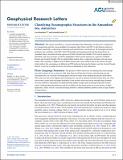Files in this item
Classifying oceanographic structures in the Amundsen Sea, Antarctica
Item metadata
| dc.contributor.author | Boehme, Lars | |
| dc.contributor.author | Rosso, Isabella | |
| dc.date.accessioned | 2021-03-09T15:30:08Z | |
| dc.date.available | 2021-03-09T15:30:08Z | |
| dc.date.issued | 2021-03-16 | |
| dc.identifier | 268565702 | |
| dc.identifier | e3d1e130-59bb-4330-9bdc-3abfb4adcaf1 | |
| dc.identifier | 85102511016 | |
| dc.identifier | 000627892100048 | |
| dc.identifier.citation | Boehme , L & Rosso , I 2021 , ' Classifying oceanographic structures in the Amundsen Sea, Antarctica ' , Geophysical Research Letters , vol. 48 , no. 5 , e2020GL089412 . https://doi.org/10.1029/2020GL089412 | en |
| dc.identifier.issn | 0094-8276 | |
| dc.identifier.uri | https://hdl.handle.net/10023/21573 | |
| dc.description | Funding: The TARSAN project was funded by the U.S. National Science Foundation, Office of Polar Programs (Grant #1738992) and the UK Natural Environment Research Council (NERC, NE/S006591/1). I.R. was supported by the National Science Foundation’s Southern Ocean Carbon and Climate Observations and Modeling SOCCOM) project under NSF Award PLR-1425989, with additional support from NOAA and NASA. | en |
| dc.description.abstract | The remote and often ice‐covered Amundsen Sea Embayment in Antarctica is important for transporting relatively warm modified Circumpolar Deep Water (mCDW) to the Western Antarctic Ice Sheet, potentially accelerating its thinning and contribution to sea level rise. To investigate potential pathways and variability of mCDW, 3809 CTD profiles (instrumented seal and ship‐based data) are classified using a machine learning approach (Profile Classification Model). Five vertical regimes are identified, and areas of larger variability highlighted. Three spatial regimes are captured: Off‐Shelf, Eastern and Central Troughs. The on‐shelf profiles further show a separation between cold and warm modes. The variability is higher north of Burke Island and at the southern end of the Eastern Trough, which reflects the convergence of different mCDW pathways between the Eastern and the Central Trough. Finally, a clear but variable clockwise circulation is identified in Pine Island Bay. | |
| dc.format.extent | 2644757 | |
| dc.language.iso | eng | |
| dc.relation.ispartof | Geophysical Research Letters | en |
| dc.subject | Amundsen Sea | en |
| dc.subject | Pine Island glacier | en |
| dc.subject | Circumpolar deep water | en |
| dc.subject | Machine learning | en |
| dc.subject | Unsupervised clustering | en |
| dc.subject | Thwaites glacier | en |
| dc.subject | GE Environmental Sciences | en |
| dc.subject | GC Oceanography | en |
| dc.subject | 3rd-DAS | en |
| dc.subject.lcc | GE | en |
| dc.subject.lcc | GC | en |
| dc.title | Classifying oceanographic structures in the Amundsen Sea, Antarctica | en |
| dc.type | Journal article | en |
| dc.contributor.sponsor | NERC | en |
| dc.contributor.institution | University of St Andrews. Sea Mammal Research Unit | en |
| dc.contributor.institution | University of St Andrews. Marine Alliance for Science & Technology Scotland | en |
| dc.contributor.institution | University of St Andrews. Scottish Oceans Institute | en |
| dc.contributor.institution | University of St Andrews. School of Biology | en |
| dc.identifier.doi | 10.1029/2020GL089412 | |
| dc.description.status | Peer reviewed | en |
| dc.identifier.grantnumber | NE/S006591/1 | en |
This item appears in the following Collection(s)
Items in the St Andrews Research Repository are protected by copyright, with all rights reserved, unless otherwise indicated.

